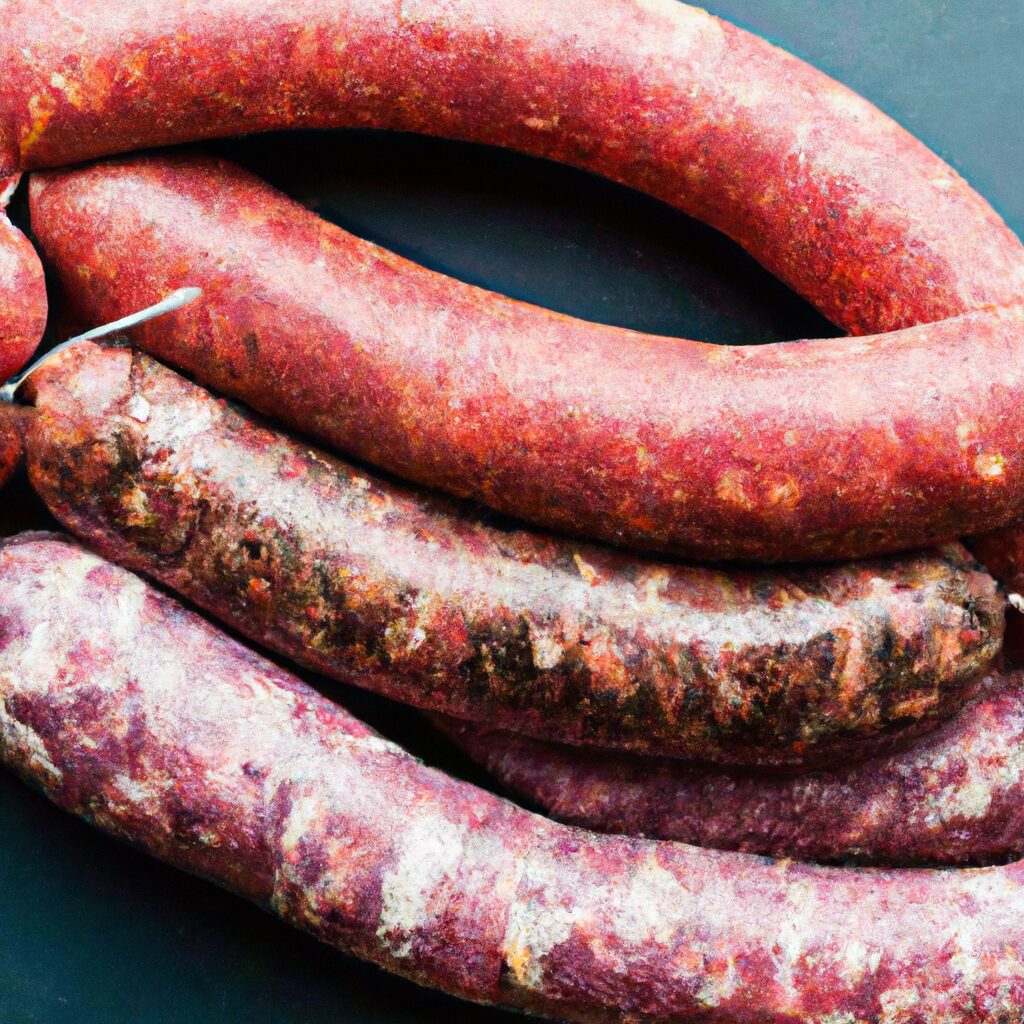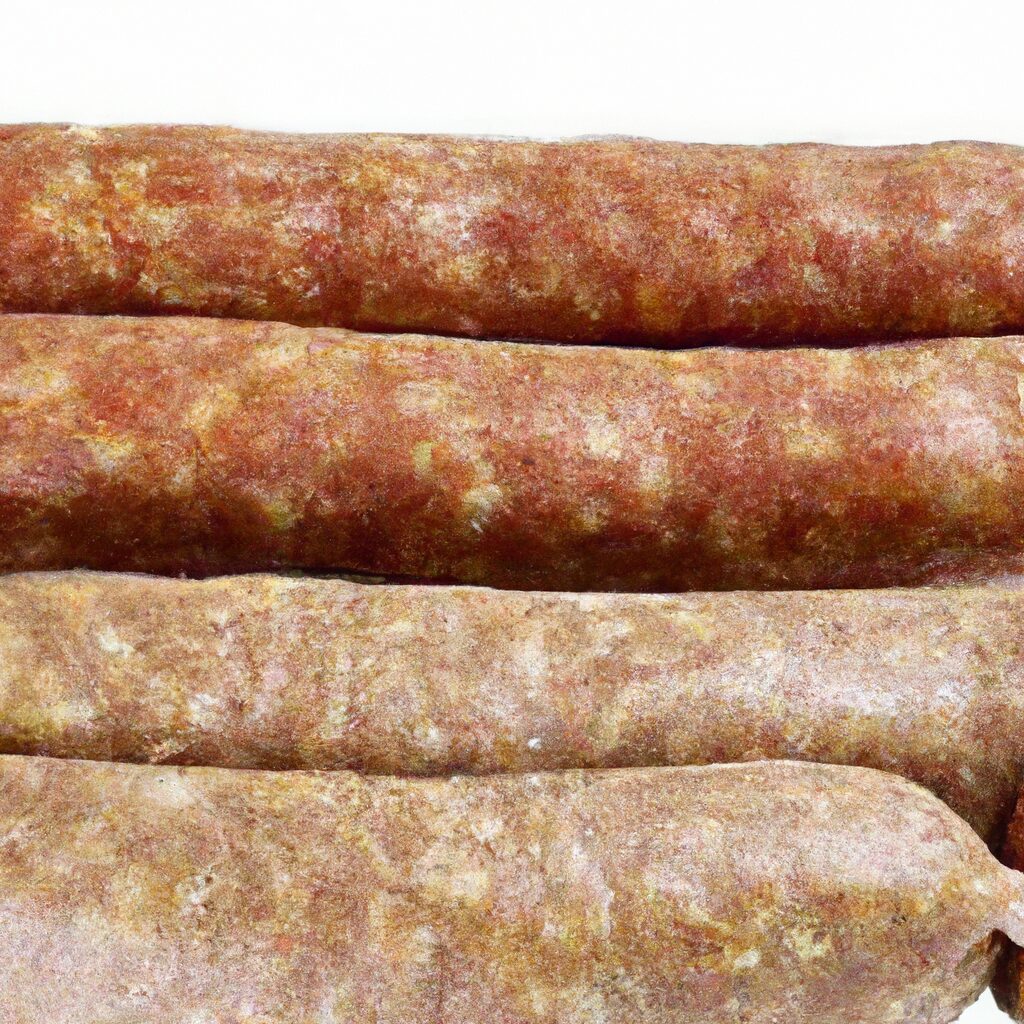
Are you curious about the best cuts of meat for making pork sausage? Well, look no further! Making sausages at home is easier than you might think, and the key lies in the meat-to-fat ratio.
To achieve the perfect balance, you’ll want to stick to the 80-20 rule, which means 80% lean meat and 20% fat. While cuts with “loin” in the name, such as pork loin roast or pork tenderloin, are not suitable due to their leanness, bacon is also a no-go since it is mostly fat.
Instead, the ideal choice is pork shoulder or pork butt, which naturally has that perfect ratio. However, if you only have leaner cuts available, fear not! You can always add some fat to the mixture or ask your butcher for excess pork fat.
As long as you maintain that 80-20 ratio, you’re free to get creative and discover your favorite flavor combinations. So roll up your sleeves, get your meat grinder ready, and start making your own delicious sausages right at home!
Best Cuts of Pork for Sausage Making


This image is the property of www.thedailymeal.com.
If you are planning to make sausage, it is important to choose the right cuts of meat. Pork is the most commonly used meat for sausages, and there are specific cuts that work best for this purpose.
When it comes to sausage making, two cuts of pork stand out: pork shoulder (also known as pork butt) and adding fat to lean cuts.
Let’s explore the advantages and disadvantages of different cuts and why pork shoulder is considered the ideal cut for sausages.
The importance of meat-to-fat ratio
When making sausages, the meat-to-fat ratio is crucial for achieving the desired texture and flavor. A perfect balance between lean meat and fat is essential for creating juicy and flavorful sausages.
Without enough fat, the sausages can turn out dry, while too much fat can result in a wet and slimy texture. Finding the right meat-to-fat ratio is the key to successful sausage making.
Avoiding dry sausages
Nobody wants to bite into a dry, flavorless sausage. That’s why it is important to choose cuts of meat that have a sufficient amount of fat. Lean cuts like pork loin roast and pork tenderloin are not suitable for sausage making because they lack the necessary fat content. These cuts can result in dry sausages that are not enjoyable to eat.
Avoiding wet and slimy sausages
On the other hand, using cuts with too high of fat content can lead to sausages that have a greasy and slimy texture. The excess fat can overpower the flavors and make the sausages unappealing. It is important to strike a balance and choose cuts that have just the right amount of fat.
Pork Shoulder: The Ideal Cut
When it comes to sausage making, pork shoulder, also known as pork butt, is considered the ideal cut of meat. It has the perfect meat-to-fat ratio, typically around 80% lean meat and 20% fat. This ratio ensures that the sausages are juicy, flavorful, and have a nice texture.
Pork shoulder is often used in barbecue recipes due to its tender meat and rich flavor. It is a versatile cut that works beautifully for sausages as well. The marbling of fat throughout the meat provides the necessary moisture and flavor, resulting in sausages that are moist and delicious.
In addition to its ideal fat content, pork shoulder is also suitable for sausage making because of its texture. It is relatively easy to grind and has a good consistency that lends itself well to the compact and uniform texture of sausages. The flavor of pork shoulder is also pleasing, making it a popular choice among sausage makers.
Creative Alternatives to Pork Shoulder
While pork shoulder is the go-to cut for sausages, there are creative alternatives that can be used if you don’t have access to it. Leaner cuts of pork can still be used for sausage making by adding fat to the mixture. By calculating the meat-to-fat ratios, you can determine the amount of fat needed to achieve the desired balance.
Butchers often sell excess pork fat, which can be added to leaner cuts to increase the fat content. This allows you to customize the fat-to-lean meat ratio and create sausages with the desired texture and flavor. With a bit of creativity and the right calculations, you can make leaner cuts work for sausage making.
Calculating Meat-to-Fat Ratios


To achieve the perfect meat-to-fat ratio, it is important to calculate the required amount of fat accurately. This will ensure that your sausages have the right balance of flavors and textures. Here are some guidelines for calculating meat-to-fat ratios:
- Determine the total weight of the lean meat you are using.
- Decide on the desired fat percentage in your sausages.
- Calculate the weight of fat needed based on the desired fat percentage.
- Subtract the weight of the fat from the total weight of the lean meat to determine the amount of lean meat needed.
By following these mathematical calculations and guidelines, you can achieve the desired meat-to-fat ratio and create sausages that are flavorful and moist.
Exploring Flavor Combinations
Sausage making allows for a wide range of flavor combinations. You can experiment with different cuts of meat and various herbs, spices, and seasonings to create personalized sausage flavors.
The choice of meat can affect the overall taste and texture of the sausages, so don’t be afraid to try different combinations.
By exploring flavor combinations, you can discover your personal favorites and tailor the sausages to your preferences. Whether you prefer a spicy and bold flavor or a more subtle and aromatic taste, there are endless possibilities when it comes to sausage making.
Other Considerations for Sausage Making
In addition to choosing the right cuts of meat and achieving the desired meat-to-fat ratio, there are other factors to consider when making sausages.
Grinding and mixing techniques
Proper grinding and mixing techniques are crucial for achieving the right texture in your sausages. The meat should be ground to a specific consistency, depending on the type of sausages you are making. Mixing the ingredients thoroughly ensures that the flavors are evenly distributed throughout the sausages.
Equipment and tools needed
To make sausages at home, you will need certain equipment and tools. A meat grinder attachment for a stand mixer is a valuable tool for grinding the meat. Sausage stuffing tubes are also necessary for filling the casings. It is important to have these tools on hand to make the sausage-making process easier and more efficient.
Cleaning and maintenance


After making sausages, it is important to clean all equipment and tools thoroughly. This helps prevent cross-contamination and ensures that the sausages are safe to eat. Regular maintenance of the equipment keeps it in good working condition and extends its lifespan.
Tips for Cooking and Storing Sausages
Once your sausages are made, it is important to know how to cook and store them properly to maintain their quality and flavor.
Cooking methods and temperature
Sausages can be cooked in various ways, including grilling, frying, or baking. The cooking method and temperature depend on the type of sausages and personal preference. It is important to cook sausages thoroughly to ensure they are safe to eat. Use a meat thermometer to check the internal temperature and make sure it reaches the recommended temperature.
Storage and preservation techniques
If you have leftover sausages or want to store them for future use, proper storage techniques are essential. Cooked sausages can be refrigerated for a few days or frozen for more extended storage. It is important to package the sausages properly to prevent freezer burn and maintain their quality.
Reheating and serving suggestions
When reheating sausages, it is best to do so slowly and gently to avoid drying them out. You can reheat sausages on the stovetop, in the oven, or on the grill. Serve the sausages with your favorite accompaniments, such as sauerkraut, mustard, or grilled vegetables, to enhance the flavors.
Sausage Recipes and Variations
Sausage making offers endless possibilities for recipes and variations. There are traditional pork sausage recipes that you can follow, as well as regional and international sausage variations to explore. Incorporating different spices, herbs, and seasonings allows you to create unique flavor combinations and customize the sausages to your liking.
Whether you are a fan of spicy Italian sausages, smoky and savory bratwursts, or aromatic chorizo, there is a recipe or variation to suit every taste. Don’t be afraid to experiment and try new flavors to discover your personal favorites.
Health and Nutritional Factors
While sausages are undeniably delicious, it is important to consider health and nutritional factors when consuming them. Sausages can be high in calories and fat, especially if made with fatty cuts of meat or added fats. However, there are ways to make healthier sausage choices.
Calorie and fat content considerations
Choosing lean cuts of meat or using a combination of lean meat and added fat can help reduce the calorie and fat content of sausages. Opting for chicken or turkey sausages can also be a healthier choice. By making conscious decisions about the ingredients and ratios, you can enjoy sausages while being mindful of your dietary needs.
Choosing healthier options
In addition to controlling the meat-to-fat ratio, you can also choose healthier ingredients when making sausages. Using fresh herbs, spices, and natural seasonings instead of processed ones adds flavor without adding unnecessary sodium or preservatives.
Avoiding artificial additives and fillers ensures that your sausages are made from wholesome ingredients.
Balancing dietary needs
Everyone’s dietary needs and preferences are different. It is essential to balance your sausage consumption with other nutritious foods and make choices that align with your health goals. Incorporating a variety of fruits, vegetables, whole grains, and lean proteins into your diet alongside sausages can help maintain a balanced and healthy eating plan.
In conclusion, choosing the best cuts of pork for sausage making is crucial for achieving flavorful and moist sausages. Pork shoulder, with its ideal meat-to-fat ratio, is the preferred cut for sausages.
However, with some creativity and calculations, leaner cuts of pork can be used by adding fat to the mixture.
Exploring different flavors, mastering grinding and mixing techniques, and considering cooking and storage tips will elevate your sausage-making skills.
Remember to balance health and nutritional factors by choosing leaner options and incorporating a variety of wholesome ingredients into your diet. With these tips and guidelines, you can enjoy the process of making sausages and create personalized recipes that suit your taste preferences.
The Ultimate Guide To Grilled Asparagus Recipes
What Vegetarian Recipes Should You Try?
What Are The Best Grilling Recipes For Camping?
7 Grilling Recipe Books To Satisfy Your Cravings
Steps For Making Three Different Marinades for Grilled Chicken







